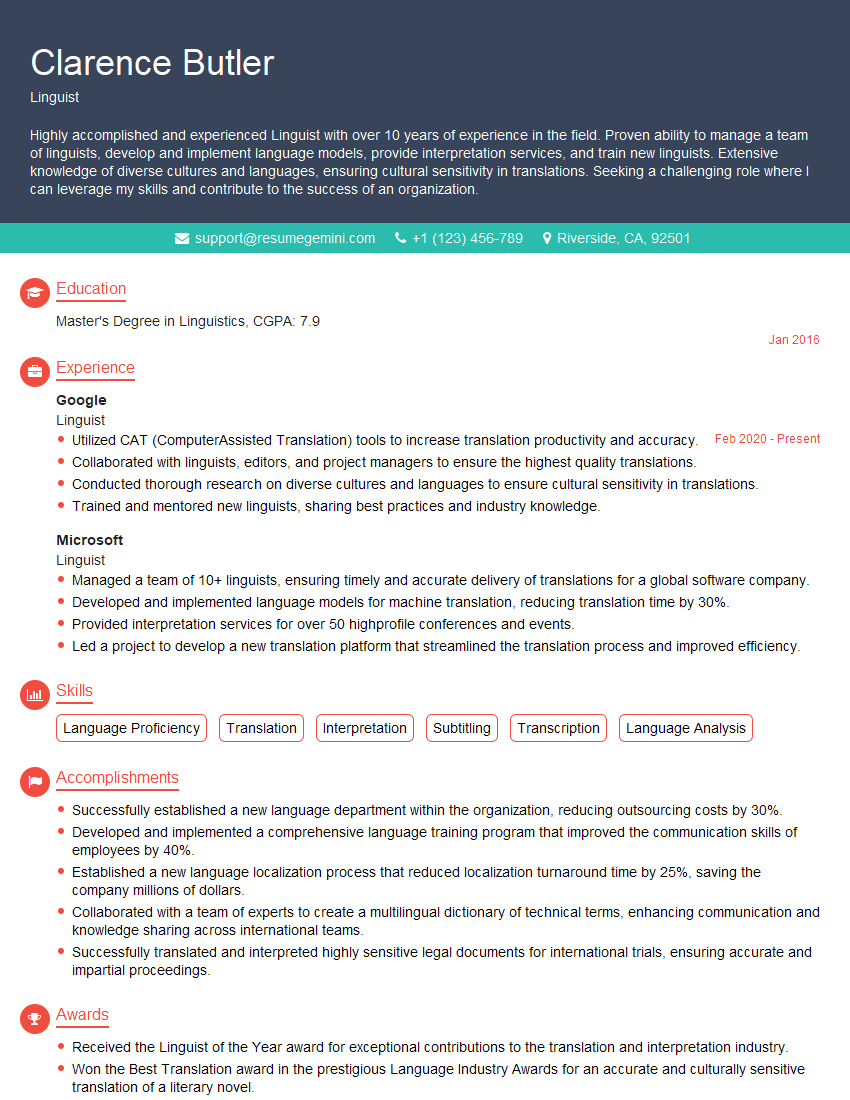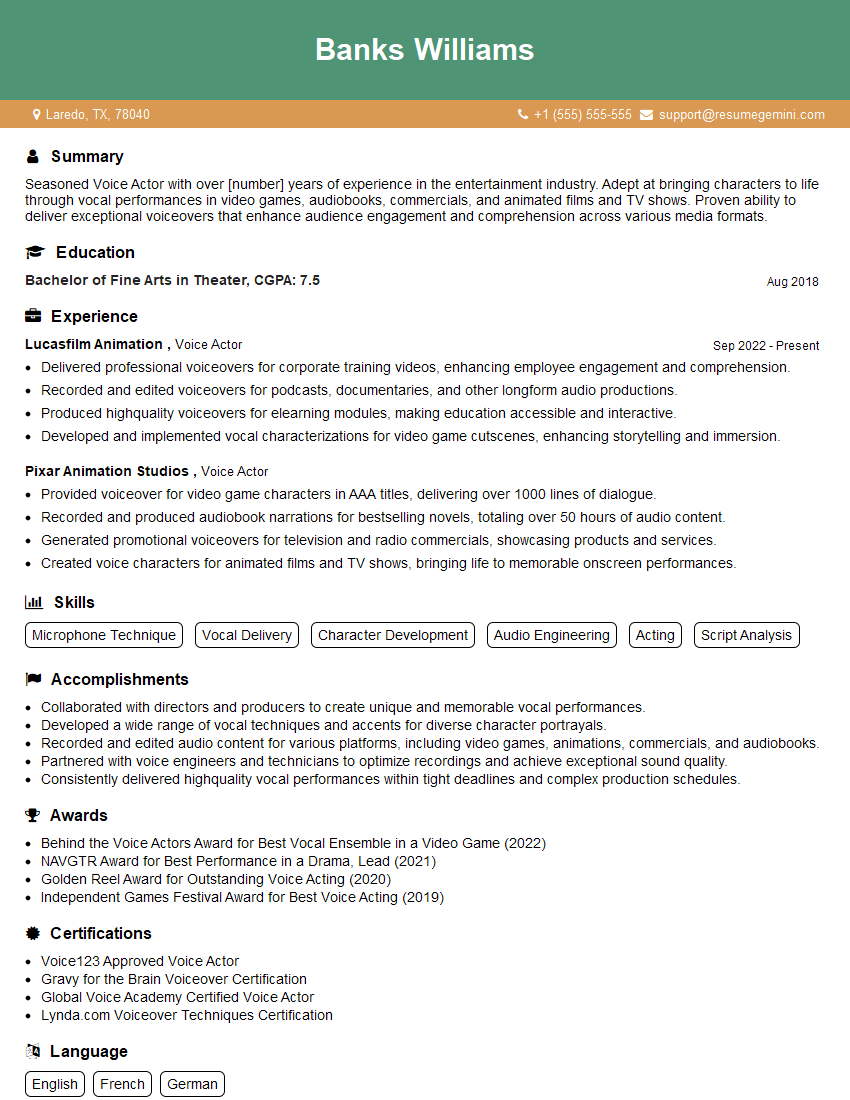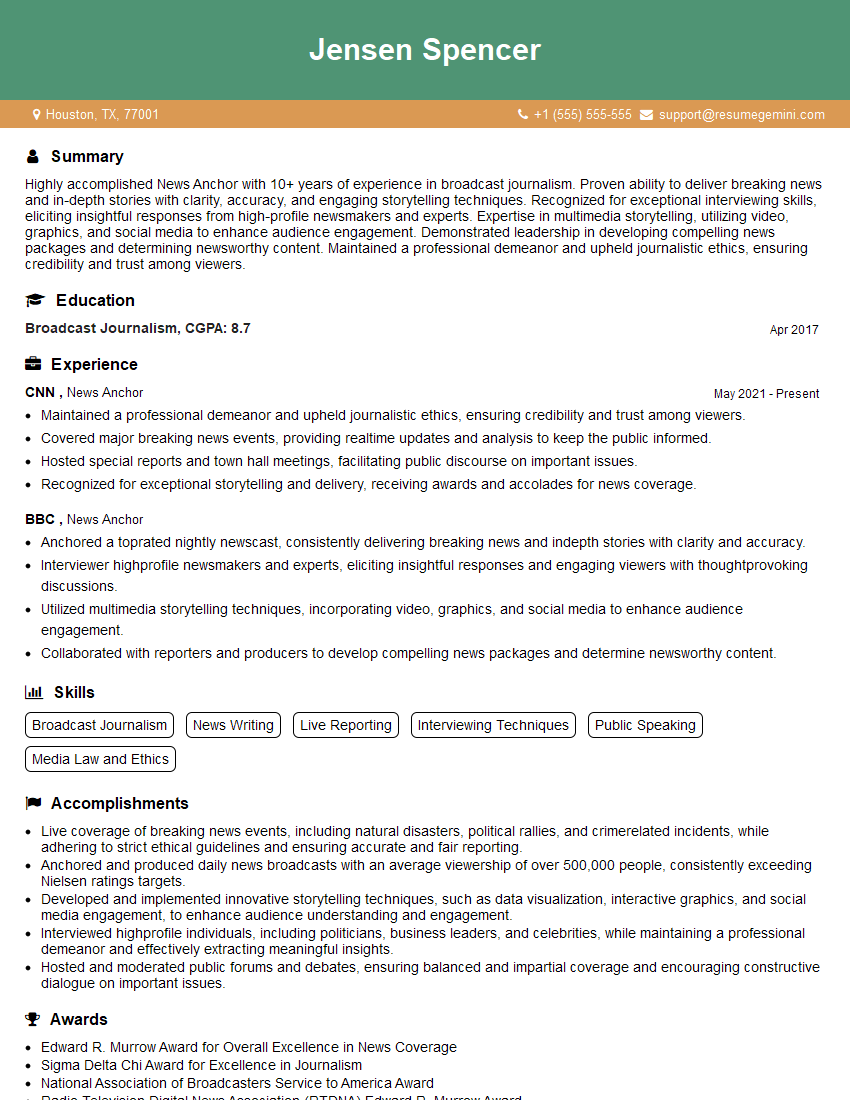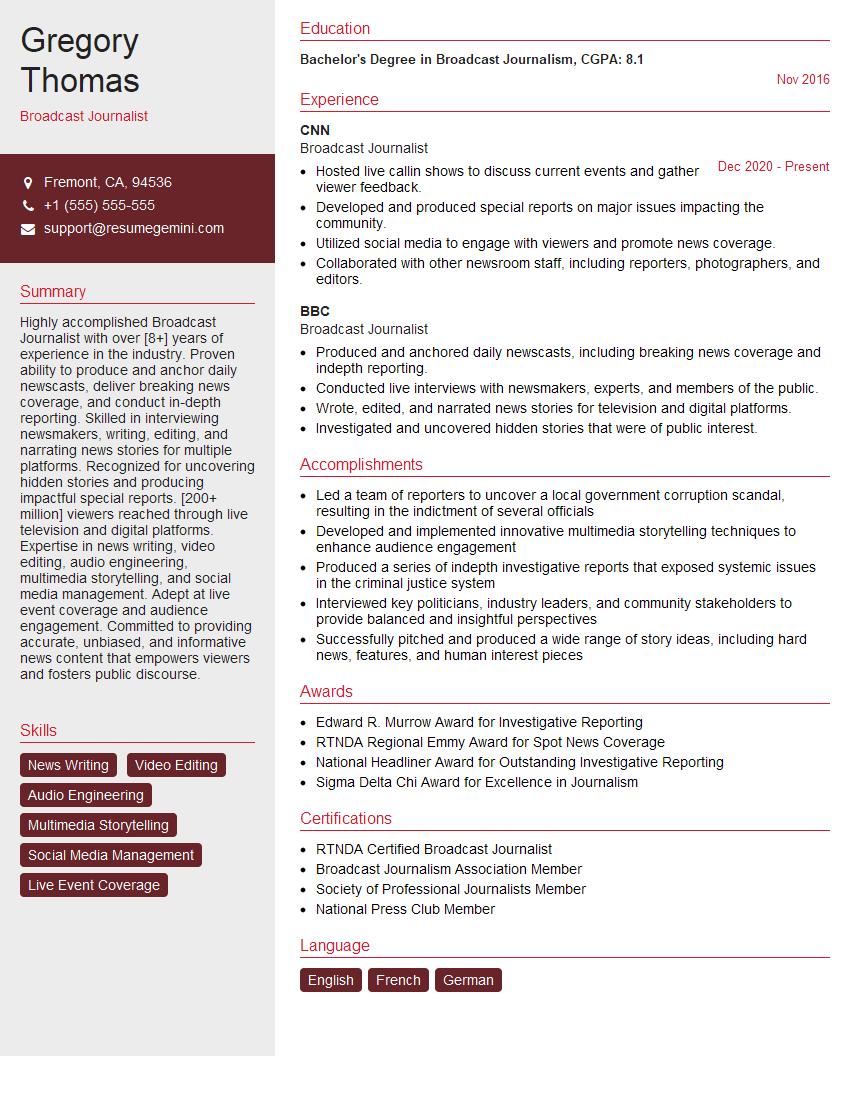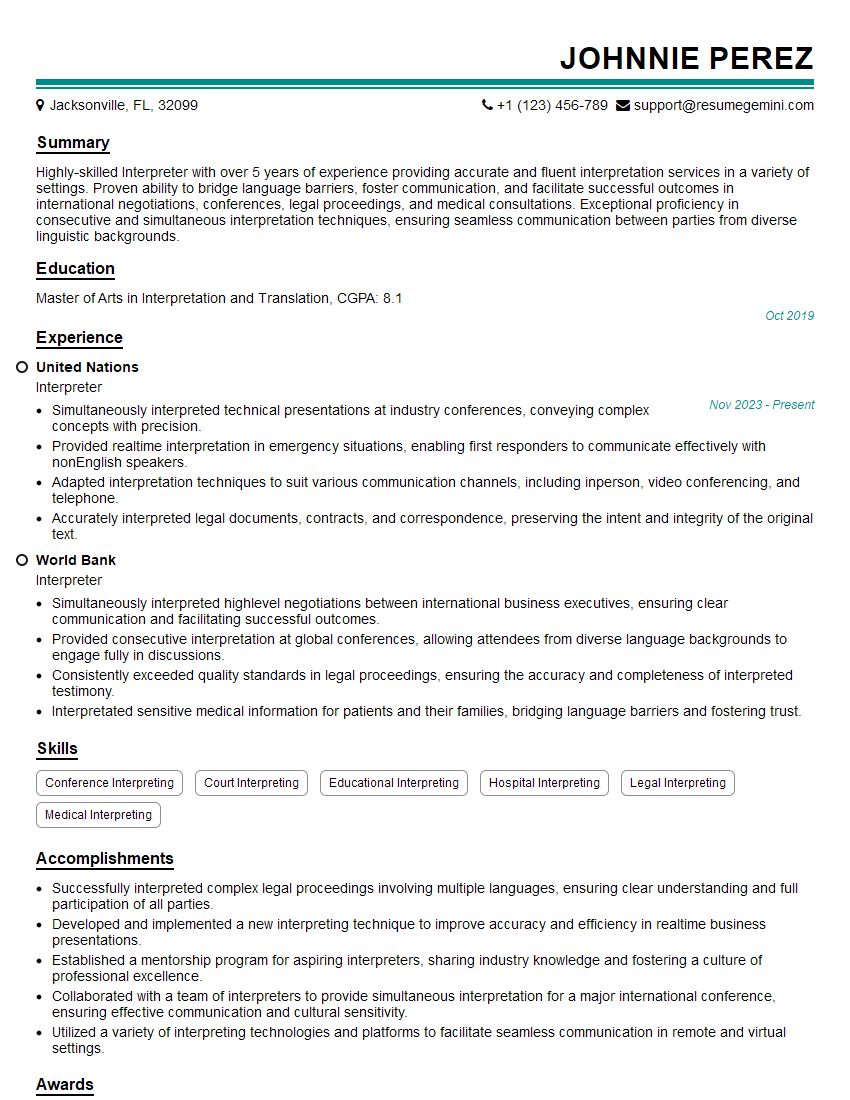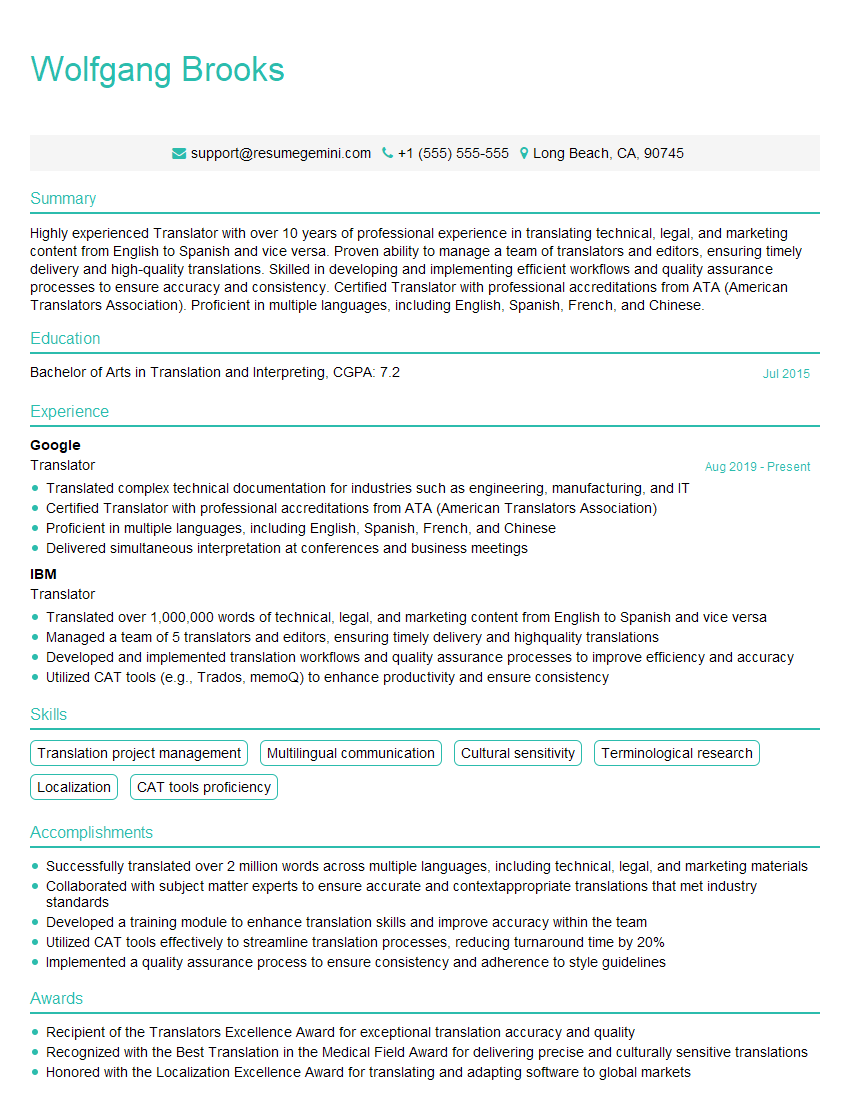Interviews are opportunities to demonstrate your expertise, and this guide is here to help you shine. Explore the essential Passion for language, communication, and the spoken arts interview questions that employers frequently ask, paired with strategies for crafting responses that set you apart from the competition.
Questions Asked in Passion for language, communication, and the spoken arts Interview
Q 1. Explain the difference between denotation and connotation in language.
Denotation and connotation are two crucial aspects of semantics, the study of meaning in language. Denotation refers to the literal, dictionary definition of a word—its objective meaning. Connotation, on the other hand, refers to the emotional, cultural, or subjective associations connected to a word, extending beyond its literal definition.
For example, the word ‘home’ denotes a place of residence. However, its connotation evokes feelings of warmth, comfort, security, and belonging—these are subjective and vary based on individual experiences.
Similarly, the word ‘cheap’ denotes low price. However, its connotation can be positive (a good bargain) or negative (low quality). Understanding both denotation and connotation is vital for effective communication, as misinterpretations easily arise if only the literal meaning is considered.
Q 2. Describe your experience using different communication styles for various audiences.
My experience with adapting communication styles involves tailoring my approach to suit diverse audiences. For example, when presenting research findings to academic peers, I employ a formal tone, utilize technical jargon relevant to the field, and focus on data-driven evidence. The language is precise and the structure logical.
However, when communicating the same research to a general audience, say at a public lecture, I simplify the technical aspects, use more accessible language, and focus on the broader implications and real-world applications. I employ storytelling and analogies to make the information relatable and engaging. Similarly, communicating with students requires a different, more interactive and encouraging approach, focusing on clarity and building confidence.
Q 3. How do you adapt your communication approach based on the communication channel used (e.g., email vs. presentation)?
The communication channel significantly influences my approach. Emails, for instance, require conciseness, clarity, and professionalism. I prioritize a structured format with a clear subject line, bullet points for key information, and a professional closing. Emojis are generally avoided.
Presentations, conversely, allow for a more dynamic and engaging style. I leverage visual aids, incorporate storytelling, maintain eye contact, and encourage interaction. The tone can be more conversational and emotive. A formal report, on the other hand, demands detailed precision, accurate referencing and a formal tone.
In short, I adapt the level of formality, length, and style to suit the channel, ensuring effective message transmission.
Q 4. How would you handle a situation where you need to deliver bad news effectively?
Delivering bad news requires empathy, directness, and a structured approach. I begin by acknowledging the recipient’s feelings and expressing sympathy. Next, I clearly and concisely state the bad news, offering a simple, straightforward explanation without unnecessary detail or jargon. Then, I focus on solutions or support available to mitigate the impact of the bad news. Finally, I offer a plan of action for moving forward.
For example, if I needed to inform a team about project delays, I would start by acknowledging the disappointment and then explain the cause of the delay transparently. I’d follow by proposing a revised timeline with clear steps and offer resources to help them manage the changes. The goal is to maintain trust and encourage collaboration.
Q 5. What strategies do you employ to ensure clear and concise communication?
Clear and concise communication involves several key strategies. First, I carefully consider my audience and tailor my language accordingly. I prioritize using precise language, avoiding jargon or ambiguity. I structure my message logically, using bullet points, headings, and short paragraphs to enhance readability.
I also actively seek feedback to ensure understanding and address any confusion. Before delivering a crucial message, I often have a colleague review it to ensure clarity and conciseness. This iterative process helps remove redundancies and streamlines communication.
Q 6. Discuss your experience with nonverbal communication and its impact.
Nonverbal communication plays a vital role in conveying meaning and shaping perception. Body language, including posture, facial expressions, and gestures, significantly impacts how a message is received. For example, maintaining eye contact demonstrates engagement and confidence, while crossed arms might suggest defensiveness.
In my experience, mirroring another person’s body language subtly can build rapport, while maintaining open and inviting posture fosters trust and collaboration. Conversely, ignoring nonverbal cues can lead to miscommunication and misunderstandings. Active observation of nonverbal cues allows for improved understanding and a more effective communication exchange.
Q 7. How do you ensure your message is culturally sensitive and inclusive?
Cultural sensitivity and inclusivity are paramount. I ensure my language avoids stereotypes, bias, and potentially offensive terms. I am mindful of cultural differences in communication styles, such as directness versus indirectness, high-context versus low-context communication. I research and familiarize myself with the cultural backgrounds of my audience to appropriately tailor my approach.
For instance, when addressing a multicultural group, I avoid using idioms or slang that may not be universally understood. Instead, I favor clear, simple language and provide context to ensure the message is accessible and inclusive to everyone. Active listening and feedback mechanisms also helps avoid potential offense.
Q 8. Describe a time you had to overcome a communication barrier.
Communication barriers are inevitable, but overcoming them is crucial for effective interaction. One instance involved collaborating on a theatrical production with a team member who primarily communicated through nonverbal cues and visual aids. My initial attempts at direct, verbal communication were unsuccessful. I recognized this as a cultural difference and a personal communication style preference. To overcome this, I adapted my approach. Instead of solely relying on words, I incorporated visual aids into our discussions, utilizing storyboards and sketches to illustrate concepts. I also slowed down my speech and actively observed their body language, using their nonverbal cues to gauge understanding. This shift towards multi-modal communication, which considered both verbal and non-verbal aspects, fostered a more effective collaboration, culminating in a successful production. This experience taught me the importance of adaptability and the power of recognizing and respecting diverse communication styles.
Q 9. How proficient are you in public speaking, and what techniques do you use?
I’m highly proficient in public speaking. My approach is multifaceted and focuses on connection, clarity, and confidence. Firstly, thorough preparation is essential. I craft a clear narrative structure, ensuring a logical flow of ideas. This involves outlining key points, creating compelling opening and closing statements, and crafting engaging transitions. Secondly, I utilize various techniques to engage my audience. This might include incorporating storytelling, humor (when appropriate), and interactive elements such as posing questions or conducting polls. Thirdly, I manage my stage presence by focusing on maintaining eye contact, using confident body language, and modulating my voice to maintain audience interest. Finally, I always practice my delivery extensively. This helps me to internalize the speech and project confidence. For instance, in a recent conference presentation, I utilized storytelling to illustrate the impact of linguistic diversity. This relatable approach effectively resonated with the audience, sparking meaningful engagement and discussion.
Q 10. Explain your understanding of active listening.
Active listening isn’t simply hearing; it’s fully engaging with the speaker and understanding their message on multiple levels. It requires undivided attention, empathy, and a conscious effort to comprehend both the verbal and nonverbal cues. This involves several key elements: paying close attention to the speaker’s words, observing their body language, asking clarifying questions to ensure understanding, and summarizing key points to confirm comprehension. For example, when mentoring a junior colleague, I practice active listening by avoiding interruptions, mirroring their body language to show engagement, and paraphrasing their concerns to confirm I fully grasped their perspectives before offering solutions. This approach creates a safe space for open communication and fosters stronger working relationships built on mutual understanding and trust.
Q 11. How do you handle conflict in a communication setting?
Conflict is inevitable in any communication setting. My approach focuses on de-escalation, empathy, and collaborative resolution. I begin by actively listening to all parties involved, seeking to understand their perspectives without judgment. Then, I identify the root cause of the conflict, focusing on the issues rather than personalities. After that, I facilitate a collaborative discussion, encouraging all parties to express their needs and concerns openly and respectfully. I guide the discussion towards finding mutually acceptable solutions, focusing on compromise and win-win outcomes. Finally, I ensure a clear understanding and agreement are reached and documented. In a recent team meeting, a disagreement arose regarding project timelines. By employing this approach, I guided the team towards a compromise that considered individual team member’s capabilities and the overall project goals. This resulted in a revised, realistic timeline that satisfied all parties involved.
Q 12. How do you prioritize and manage multiple communication projects simultaneously?
Managing multiple communication projects necessitates effective organization and prioritization. I utilize project management tools and techniques to stay on top of deadlines and deliverables. This includes creating detailed project timelines, assigning clear responsibilities, and setting realistic goals. I also utilize time-blocking and task prioritization techniques. This approach enables me to focus my energy on the most critical tasks first, ensuring high-impact communication efforts are delivered effectively. Furthermore, I leverage technology to streamline communication, utilizing collaborative platforms to ensure transparency and seamless workflow across different projects. By implementing these strategies, I can handle numerous communication projects simultaneously without compromising quality or effectiveness. For example, in my previous role, I successfully managed simultaneous projects involving a company-wide internal communications campaign, a major product launch announcement, and a series of stakeholder engagement events.
Q 13. Describe your experience with persuasive writing or speaking.
Persuasive writing and speaking are fundamental to my skill set. I’ve honed this ability through years of experience crafting compelling narratives, presentations, and marketing materials. My approach combines a strong understanding of the audience’s needs and motivations with the strategic use of rhetorical devices and storytelling techniques. For example, in developing a marketing campaign, I carefully researched the target audience, their values, and their preferences. This understanding informed the tone, style, and message of the campaign. Then, by integrating storytelling elements, emotional appeals, and logical arguments, the final campaign effectively resonated with the target audience, leading to significant success in terms of product adoption and brand awareness. This exemplifies the power of audience-centric communication.
Q 14. How familiar are you with different rhetorical devices?
I’m very familiar with various rhetorical devices and how to deploy them effectively. This includes understanding and using:
- Ethos (credibility): Establishing trust and authority through expertise and experience.
- Pathos (emotion): Connecting with the audience’s emotions to evoke empathy and understanding.
- Logos (logic): Using reason and evidence to support claims and build a convincing argument.
- Metaphors and Similes: Creating vivid imagery and making complex ideas more accessible.
- Analogies: Drawing comparisons to illustrate a point and aid understanding.
- Repetition: Emphasizing key messages to enhance memorability.
Understanding and utilizing these devices allows for a richer and more persuasive communication experience.
Q 15. What are your strengths and weaknesses in written and verbal communication?
My strengths in verbal communication lie in my ability to adapt my style to different audiences and contexts. I can effortlessly switch between formal presentations and informal conversations, ensuring my message resonates. I’m also a skilled storyteller, using narrative to engage listeners and make complex information more accessible. For example, when explaining a challenging linguistic concept to a group of students, I might use a relatable analogy from popular culture to make it easier to grasp. In written communication, I excel at clarity and conciseness. I meticulously craft my writing to ensure it’s free of ambiguity and achieves its intended purpose. My weakness, however, is sometimes getting overly detailed in my written work, which can occasionally overwhelm the reader. To counter this, I’m actively working on improving my editing skills and focusing on prioritizing key information.
Conversely, while I’m comfortable public speaking, I occasionally struggle with impromptu speaking, particularly in high-pressure situations. I am working on improving my ability to think on my feet through regular practice and participation in improvisational exercises.
Career Expert Tips:
- Ace those interviews! Prepare effectively by reviewing the Top 50 Most Common Interview Questions on ResumeGemini.
- Navigate your job search with confidence! Explore a wide range of Career Tips on ResumeGemini. Learn about common challenges and recommendations to overcome them.
- Craft the perfect resume! Master the Art of Resume Writing with ResumeGemini’s guide. Showcase your unique qualifications and achievements effectively.
- Don’t miss out on holiday savings! Build your dream resume with ResumeGemini’s ATS optimized templates.
Q 16. How do you assess the effectiveness of your communication efforts?
Assessing the effectiveness of my communication is a multi-faceted process. Firstly, I always consider the immediate feedback I receive. This could be nonverbal cues from the audience during a presentation – their engagement, facial expressions, and questions. In written communication, I look for responses that indicate whether the reader understood my message. For example, if I’ve sent a proposal, I’ll look for follow-up questions or an indication that the proposal has been acted upon. Secondly, I measure the impact of my communication against its intended goals. Did the presentation persuade the audience? Did the written document achieve its objective? I might use metrics such as audience survey results, sales figures (in a sales presentation), or the successful completion of a project based on instructions provided in a written document. Finally, I regularly seek constructive criticism from colleagues and mentors to gain external perspectives on my communication skills.
Q 17. Describe your experience with different presentation software and tools.
I’m proficient in a range of presentation software and tools. My go-to is Microsoft PowerPoint, which I use to create visually appealing and informative presentations. I’m also comfortable with Google Slides for collaborative projects and Prezi for more dynamic and non-linear presentations. Beyond presentation software, I’ve used tools like Canva for creating visually engaging graphics and Adobe Illustrator for designing more sophisticated visual elements. I’m familiar with using screen recording software for creating instructional videos and webinars and audio editing software to enhance audio quality for podcasts or presentations. My skills extend to incorporating multimedia elements, such as videos and audio clips, to make my presentations more engaging and informative. I regularly explore new tools and features to ensure my presentations are up-to-date and effective.
Q 18. How do you maintain professionalism in challenging communication scenarios?
Maintaining professionalism in challenging communication scenarios requires a combination of skills and strategies. Firstly, it’s crucial to remain calm and composed, even when faced with difficult individuals or situations. Secondly, I practice active listening – truly understanding the other person’s perspective before responding. I focus on using neutral and objective language, avoiding emotional outbursts or personal attacks. For example, if someone is being aggressive, I might say something like, “I understand your frustration, and I want to find a solution together. Let’s focus on the facts.” I also prioritize clear and concise communication, ensuring my message is easily understood, even amidst the stress. Finally, I document everything; if a difficult conversation occurs, I will usually write a summary of the interaction afterward to ensure clarity and avoid future misunderstandings.
Q 19. How do you stay up-to-date on current communication trends?
Staying current with communication trends is essential. I do this by actively engaging with communication-focused publications, blogs, and podcasts. I also attend webinars and workshops, and participate in professional development opportunities. Networking with other communication professionals provides valuable insights into current practices and emerging technologies. Following industry leaders on social media platforms allows me to stay informed about new ideas and trends. For instance, I recently learned about the increasing importance of accessibility in communication design and am actively incorporating these considerations into my work.
Q 20. Describe your approach to providing constructive feedback.
My approach to constructive feedback is based on the ‘sandwich method,’ which involves starting with positive reinforcement, followed by the constructive criticism, and ending with another positive note. This approach helps to soften the criticism and makes it easier for the recipient to receive and process. For example, I might say something like, “I really appreciate your creativity in this project, particularly in [specific positive aspect]. However, I think the clarity could be improved by [specific suggestion for improvement]. Overall, this is a strong piece of work, and with a few tweaks, it will be even better.” Crucially, I ensure my feedback is specific, actionable, and focused on the work, not the person. I avoid generalizations and focus on observable behaviors. I always aim for a collaborative approach, inviting a discussion about the feedback and making sure the recipient feels heard and understood.
Q 21. How do you handle criticism regarding your communication skills?
I view criticism as an opportunity for growth. I approach it with an open mind, actively listening to the feedback without getting defensive. I analyze the criticism to identify any valid points. If the criticism is constructive, I focus on learning from it and implementing changes to improve my skills. If it seems unfair or based on misunderstanding, I calmly address the issue, clarifying any points of confusion. For example, if someone criticizes my presentation style as “too formal,” I’ll ask them to explain what aspects seemed overly formal and explore alternative styles to better connect with different audiences. Ultimately, I believe that through embracing constructive criticism, I can continue to refine and enhance my communication skills.
Q 22. What is your experience with interpreting or translating languages?
My experience with interpreting and translating encompasses a wide range of languages and contexts. I’ve worked extensively with Spanish and French, both interpreting in real-time settings (consecutive and simultaneous interpretation) and translating written documents, such as legal contracts, medical reports, and marketing materials. In simultaneous interpretation, for instance, I’ve worked at international conferences, providing immediate verbal translation between speakers and the audience. My experience with written translation has focused on ensuring accuracy, cultural sensitivity, and maintaining the original tone and intent of the text. I’m proficient in using CAT tools (computer-assisted translation) to ensure consistency and efficiency.
Furthermore, I have experience in community interpreting, assisting individuals with limited English proficiency in accessing vital services. This requires not only linguistic proficiency but also cultural sensitivity and an understanding of the nuances of communication in diverse settings. This experience has sharpened my awareness of the ethical responsibilities involved in facilitating communication.
Q 23. How do you adapt your language to suit different audiences’ levels of expertise?
Adapting language to different audiences is crucial for effective communication. I tailor my language based on factors such as the audience’s prior knowledge, educational background, and cultural context. Imagine explaining quantum physics to a group of physicists versus a group of elementary school children; the level of detail and technical jargon would drastically differ. For a highly specialized audience, I’d use precise technical language, while for a less technical audience, I would utilize simpler terms, analogies, and more illustrative examples. I might also adjust my tone, moving from formal to informal depending on the setting and relationship with the audience. I always aim for clarity and conciseness, regardless of the audience’s level of expertise, ensuring the message is easily understood and impactful.
Q 24. Explain your understanding of different communication models (e.g., transactional, Shannon-Weaver).
Communication models provide frameworks for understanding how information is exchanged. The transactional model views communication as a dynamic process involving continuous feedback loops between sender and receiver. It’s not simply a one-way street; both parties simultaneously send and receive messages, influencing each other. Think of a conversation – it’s a constant exchange, with both parties interpreting and responding to each other’s verbal and nonverbal cues.
The Shannon-Weaver model, also known as the mathematical model, focuses on the technical aspects of communication, breaking it down into distinct elements: sender, encoder, channel, decoder, receiver, and noise. Noise refers to any interference that disrupts the message’s clarity, such as physical distractions or semantic misunderstandings. While simpler than the transactional model, it highlights the importance of a clear channel and minimizing interference for effective communication. For example, a poor internet connection (noise) could disrupt a video conference (channel).
Understanding both models allows for a holistic approach to communication, acknowledging both the dynamic interplay between communicators and the technical factors influencing the clarity of the message.
Q 25. Describe your experience with crisis communication.
My experience in crisis communication involves responding to sensitive and urgent situations requiring clear, concise, and empathetic communication. I’ve worked on projects where swift and accurate information dissemination was critical in mitigating damage and restoring trust. For instance, I assisted a company during a product recall, crafting press releases, social media posts, and internal communications that addressed customer concerns transparently and responsibly. The key here is not just conveying information but also calming anxieties and maintaining a positive brand image. This often involves crafting a consistent narrative across various channels and adapting the message to different audiences (customers, employees, media). Crisis communication demands a calm and decisive approach, focusing on delivering factual information with empathy and taking quick, well-informed actions.
Q 26. How do you ensure accuracy and consistency in your communication?
Ensuring accuracy and consistency in communication is paramount. For written materials, I meticulously review my work, paying attention to grammar, spelling, punctuation, and style. I frequently use style guides and dictionaries to ensure consistent terminology and usage. I also leverage technology like grammar and style checkers, but always rely on human review for nuanced aspects like tone and context. For verbal communication, clear articulation and concise phrasing are key. Active listening is critical in ensuring I understand the message accurately before responding. In translating or interpreting, I rely on reputable reference materials and cross-check my work against multiple sources to ensure accuracy and consistency. A consistent style guide, whether for documents or presentations, is essential for maintaining a professional and credible image.
Q 27. How would you address a communication breakdown in a team setting?
Addressing communication breakdowns in a team setting requires a multi-step approach. First, I would identify the source of the breakdown. Is it a misunderstanding, conflicting priorities, lack of clarity in instructions, or personality clashes? Once identified, I would facilitate open and honest dialogue, encouraging each team member to share their perspective without interruption. Active listening is key. I would then work collaboratively to find a mutually acceptable solution, focusing on shared goals and clarifying expectations. If needed, I might mediate, helping team members to understand different viewpoints and find common ground. Finally, I’d establish clear communication protocols to prevent future breakdowns, ensuring everyone is on the same page regarding reporting structures, communication channels, and expectations. Documentation and regular check-ins are also crucial to maintain transparency and accountability.
Q 28. Describe your experience using communication technology to enhance collaboration.
I have extensive experience using communication technology to enhance collaboration. I’m proficient in using various platforms for video conferencing (Zoom, Google Meet), project management (Asana, Trello), and instant messaging (Slack, Microsoft Teams). These tools facilitate real-time communication, allowing for efficient information sharing and collaboration across geographical boundaries. For instance, I’ve used project management software to organize tasks, track progress, and share documents with team members across different time zones. Video conferencing enables face-to-face communication, enhancing understanding and building relationships, even remotely. Utilizing these tools effectively allows for improved workflow, enhances transparency, and promotes efficient team collaboration regardless of location.
Key Topics to Learn for a Passion for Language, Communication, and the Spoken Arts Interview
- Effective Communication Strategies: Explore various communication models, including verbal and nonverbal cues, active listening techniques, and adapting your communication style to different audiences. Consider the impact of cultural nuances on communication.
- Rhetorical Devices and Persuasion: Understand the power of rhetoric in crafting compelling arguments and persuasive messages. Practice analyzing speeches and written works for effective use of language and persuasive techniques.
- Public Speaking and Presentation Skills: Develop your ability to deliver engaging and informative presentations. This includes structuring presentations effectively, utilizing visual aids appropriately, and managing stage presence and audience interaction.
- Storytelling and Narrative Techniques: Learn to craft compelling narratives that resonate with audiences. Explore how storytelling can be used to enhance communication and build connections.
- Language Acquisition and Linguistic Awareness: Demonstrate an understanding of language structure, dialects, and the impact of language on thought and culture. Consider the ethical considerations surrounding language use.
- Interpersonal Communication and Conflict Resolution: Develop skills in managing interpersonal relationships, navigating disagreements constructively, and resolving conflicts effectively. Emphasize collaborative communication.
- Media Literacy and Critical Analysis: Develop the ability to critically analyze different forms of media, including their impact on communication and the spread of information. Consider different perspectives and biases.
Next Steps
Mastering language, communication, and the spoken arts is crucial for career success in numerous fields. Strong communication skills are highly valued across industries, opening doors to leadership roles and enhancing your ability to collaborate effectively. To maximize your job prospects, invest in creating a polished and ATS-friendly resume that showcases your skills and experience. ResumeGemini is a trusted resource that can help you build a professional resume that highlights your unique qualifications. Examples of resumes tailored to careers in language, communication, and the spoken arts are available to help guide you. Take the next step towards your dream career – build a compelling resume today!
Explore more articles
Users Rating of Our Blogs
Share Your Experience
We value your feedback! Please rate our content and share your thoughts (optional).
What Readers Say About Our Blog
Hello,
We found issues with your domain’s email setup that may be sending your messages to spam or blocking them completely. InboxShield Mini shows you how to fix it in minutes — no tech skills required.
Scan your domain now for details: https://inboxshield-mini.com/
— Adam @ InboxShield Mini
Reply STOP to unsubscribe
Hi, are you owner of interviewgemini.com? What if I told you I could help you find extra time in your schedule, reconnect with leads you didn’t even realize you missed, and bring in more “I want to work with you” conversations, without increasing your ad spend or hiring a full-time employee?
All with a flexible, budget-friendly service that could easily pay for itself. Sounds good?
Would it be nice to jump on a quick 10-minute call so I can show you exactly how we make this work?
Best,
Hapei
Marketing Director
Hey, I know you’re the owner of interviewgemini.com. I’ll be quick.
Fundraising for your business is tough and time-consuming. We make it easier by guaranteeing two private investor meetings each month, for six months. No demos, no pitch events – just direct introductions to active investors matched to your startup.
If youR17;re raising, this could help you build real momentum. Want me to send more info?
Hi, I represent an SEO company that specialises in getting you AI citations and higher rankings on Google. I’d like to offer you a 100% free SEO audit for your website. Would you be interested?
Hi, I represent an SEO company that specialises in getting you AI citations and higher rankings on Google. I’d like to offer you a 100% free SEO audit for your website. Would you be interested?
good



